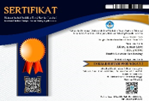Antioxidant, Antibacterial, Cytotoxic, and Anticancer Potential of Belulang Grass (Eleusine indica)
DOI:
https://doi.org/10.35799/jis.v25i1.58431Keywords:
Eleusine indica, belulang grass, cytotoxic, HeLa cellsAbstract
A study was conducted to determine the antioxidant, antibacterial, cytotoxic, and anticancer activities of the belulang grass plant (Eleusine indica). Antioxidant activity was assessed using the 2,2-Diphenyl-1-picrylhydrazyl (DPPH) free radical scavenging activity method. Antibacterial activity was determined using the disk diffusion method, cytotoxicity was determined using the Brine Shrimp Lethality Test (BSLT), and anticancer activity was evaluated using the MTS assay. The results showed that the antioxidant activity of the extracts and solvent fractions of Eleusine indica had the highest average value for the n-hexane fraction (FNH) at 35.0%, ethyl acetate fraction (FEA) at 56.4%, aqueous fraction (FA) at 30.3%, and methanol extract (EM) at 32.5%. Among these, the highest value was obtained in FEA, while the lowest was obtained in FA. Based on the cytotoxicity test with the BSLT method, the ethyl acetate fraction had an LC50 value of 7.384 ppm, categorizing it as highly toxic. However, in cytotoxicity testing with HeLa cells, the IC50 value for the ethyl acetate fraction was 223.70 ppm, indicating that the ethyl acetate fraction was less active against HeLa cervical cancer cells.
Keywords: Eleusine indica; belulang grass; cytotoxic; HeLa cells
References
Birben, E., Sahiner, U.M., Sackesen, C., Erzurum, S. & Kalayci, O. (2012). Oxidative Stress and Antioxidant Defense. World Allergy Organization Journal, 5(1), 9–19.
Carballo, J.L., Hernández-inda, Z.L., Pérez, P. & García-grávalos, M.D. (2002). A Comparison between Two Brine Shrimp Assays to Detect in Vitro Cytotoxicity in Marine Natural Products. BMC Biotechnology, 2(17), 1–5.
Corradini, E., Foglia, P., Giansanti, P., Gubbiotti, R., Samperi, R. & Laganà, A. (2011). Flavonoids: Chemical Properties and Analytical Methodologies of Identification and Quantitation in Foods and Plants. Natural Product Research, 25(5), 465–495. https://doi.org/10.1080/14786419.2010.482054.
Elfahmi, H., Woerdenbag, J. & Kayser, O. (2014). Jamu: Indonesian Traditional Herbal Medicine towards Rational Phytopharmacological Use. Perspectives in Medicine, 4(2), 51-73. https://doi.org/10.1016/j.hermed.2014.01.002.
Geran, R.S., Greenberg, N.H., Macdonald, A.M., Schumacher, M.M. & Abbott, B.J. (1972). Protocols for Screening Chemical Agents and Natural Products against Animal Tumors and Other Biological Systems. Cancer Chemotherapy Reports, 13, 1–87.
Hambali, D., Purba, E. & Kardhinata, E.H. (2015). Dose Response Biotip Rumput Belulang (Eleusine Indica [L] Gaertn.) Resisten-Parakuat Terhadap Parakuat, Diuron, Dan Ametrin. Jurnal Online Agroekoteknologi, 3(2), 574–80.
Hamidi, М.R., Jovanova, B. & Panovska, T.K. (2014). Toxicоlogical Evaluation of the Plant Products Using Brine Shrimp (Artemia salina L.) Model. Macedonian Pharmaceutical Bulletin, 60(1), 9–18. https://doi.org/10.33320/maced. pharm.bull.2014.60.01.002.
Khopkar, S.M. (1998). Basic Concepts of Analytical Chemistry, 2nd ed. New Age International, New Delhi.
Lobiuc, A., Pavăl, N-E., Mangalagiu, I.I., Gheorghita, R., Teliban, G-C., Amăriucăi-Mantu, D. & Stoleru, V. (2023). Future Antimicrobials : Natural and Functionalized Phenolics. Molecules, 28(3), 1114.
Meyer, B.N., Ferrigni, N.R., Putnam, J.E., Jacobsen, L.B., Nichols, D.E. & Mclaughlin, J.L. (1982). Brine Shrimp : A Convenient General Bioassay for Active Plant Constituents. Planta Medica, 45(5), 31–34.
Molyneux, P. (2004). The Use of the Stable Free Radical Diphenylpicryl- Hydrazyl (DPPH) for Estimating Antioxidant Activity. Songklanakarin Journal of Science and Technology, 26(2), 211–219.
Naithani, R., Huma, L.C., Moriarty, R.M., Mccormick, D.L. & Rajendra, G. (2008). Comprehensive Review of Cancer Chemopreventive Agents Evaluated in Experimen- Tal Carcinogenesis Models and Clinical Trials. Current Medicinal Chemistry, 15(11), 1044–1071.
Pietta, P-G. (2000). Flavonoids as Antioxidants. Journal of Natural Products, 63(7), 1035–1042. https://doi.org/10.1021/np9904509.
Pradana, D.L.C. & Batubara, U.M. (2015). Identifikasi Senyawa Bioaktif Dan Uji Aktivitas Antibakteri Infusa Eleusine Indica Dan Daun Morinda Citrifolia Pada Bakteri Bakteri Staphylococcus Aureus Secara In-Vitro. In Prosiding SEMIRATA 2015 Bidang MIPA BKS-PTN Barat Universitas Tanjungpura, 662–669.
Prior, R.L., Wu, X. & Schaich, K. (2005). Standardized Methods for the Determination of Antioxidant Capacity and Phenolics in Foods and Dietary Supplements. Journal of Agricultural and Food Chemistry, 53(10), 4290–4302. https://doi.org/10.1021 /jf0502698.
Putri, P.A., Chatri, M. & Advinda, L. (2023). Characteristics of Saponin Secondary Metabolite Compounds in Plants Karakteristik Saponin Senyawa Metabolit Sekunder Pada Tumbuhan Abstrak Pendahuluan. Serambi Biologi, 8(2), 251–258.
Redha, A. (2010). Flavonoid: Struktur , Sifat Antioksidatif Dan Peranannya Dalam Sistem Biologis. Berlian, 9(2), 196–202.
Setiani, D., Hastuti, E.D. & Darmanti, S. (2019). Efek Alelokimia Ekstrak Daun Babandotan (Ageratum Conyzoides L.) Terhadap Kandungan Pigmen Fotosintetik Dan Pertumbuhan Gulma Rumput Belulang (Eleusine indica (L. Gaertn.), (4), 1–7.
Suryanto, E. (2018). Kimia Antioksidan. CV Patra Media Grafindo, Bandung.
Togolo, E., Suryanto, E. & Sangi, M.S. (2013). Aktivitas Antioksidan Dari Tepung Pisang Goroho Yang Direndam Dengan Lemon Kalamansi. Jurnal MIPA, 2(2), 105–108.
Downloads
Published
How to Cite
Issue
Section
License
Copyright (c) 2025 Vanda Selvana Kamu, Max Revolta John Runtuwene, Jetlee Merentek, Harry Steven Julius Koleangan, Maureen Kumaunang

This work is licensed under a Creative Commons Attribution-NonCommercial 4.0 International License.
LICENCE: CC-BY-NC
This work is licensed under a Creative Commons Attribution-NonCommercial 4.0 International License







